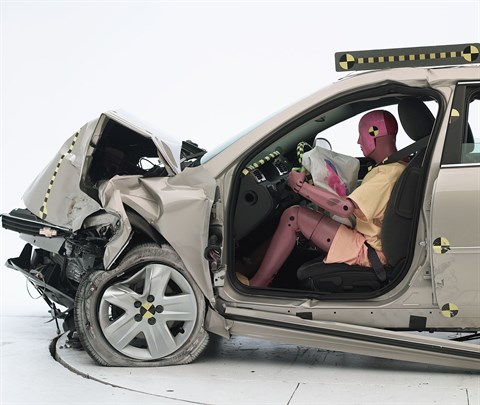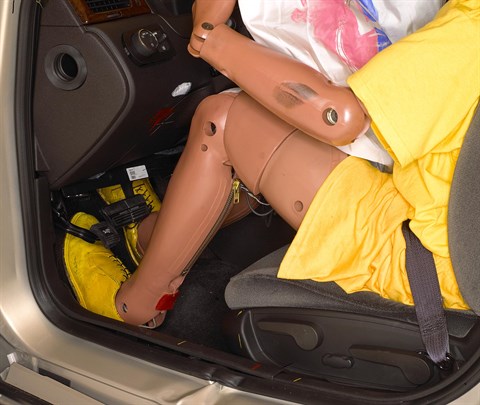Moderate overlap front: original test
Rating applies to 2010-13 models built after December 2009
Tested vehicle: 2010 Chevrolet Impala LS 4-door
The Chevrolet Impala was redesigned for the 2006 model year. Beginning with 2010 models manufactured after December 2009, structural reinforcements were added to the underbody and the frontal airbags were modified to improve occupant protection in frontal offset crashes (note: information about when a specific vehicle was manufactured is on the certification label typically affixed to the car on or near the driver door).
| Evaluation criteria | Rating |
|---|---|
| Overall evaluation | |
| Structure and safety cage | |
| Driver injury measures | |
| Head/neck | |
| Chest | |
| Leg/foot, left | |
| Leg/foot, right | |
| Driver restraints and dummy kinematics | |

Action shot taken during the frontal offset crash test.

The dummy's position in relation to the steering wheel and instrument panel after the crash test indicates that the driver's survival space was maintained well.

Dummy movement was well controlled. During rebound, the dummy's head hit only the head restraint, as indicated by smeared red greasepaint.

Forces on the right foot were high enough to indicate the possibility of injuries.
Side: original test
Rating applies to 2009-13 models
Tested vehicle: 2009 Chevrolet Impala LT 4-door with standard front and rear head curtain airbags and standard front seat-mounted torso airbags
The Chevrolet Impala was redesigned for the 2006 model year. Beginning with 2009 models, side curtain airbags were made standard for retail and fleet buyers (they had been optional for fleet buyers previously), and side airbags to protect the drivers' and front passengers' torsos also became standard (the side torso airbags were not available before).
Two tests of the Impala were conducted, one by the Institute of a 2006 model equipped with side curtain airbags, and the other by General Motors of a 2009 model with both side curtain airbags and side torso airbags. These vehicles are rated separately, except that the structural ratings for both vehicles are based on both tests, as are rear dummy injury and head protection ratings, because no changes were made to the rear occupant compartment. Driver dummy injury and head protection ratings for the 2009 model are assigned by the Institute.
| Evaluation criteria | Rating |
|---|---|
| Overall evaluation | |
| Structure and safety cage | |
| Driver injury measures | |
| Head/neck | |
| Torso | |
| Pelvis/leg | |
| Driver head protection | |
| Rear passenger injury measures | |
| Head/neck | |
| Torso | |
| Pelvis/leg | |
| Rear passenger head protection | |
Roof strength
Rating applies to 2011-13 models built after July 2010
Tested vehicle: 2011 Chevrolet Impala LT 4-door
| Overall evaluation | |
|---|---|
| Curb weight | 3,635 lbs |
| Peak force | 12,547 lbs |
| Strength-to-weight ratio | 3.45 |
Head restraints & seats
Seat type: Manual - power seats
| Overall evaluation | |
|---|---|
| Dynamic rating | |
| Seat/head restraint geometry |
About the head restraint & seat test
Currently, IIHS tests apply only to front seats.
